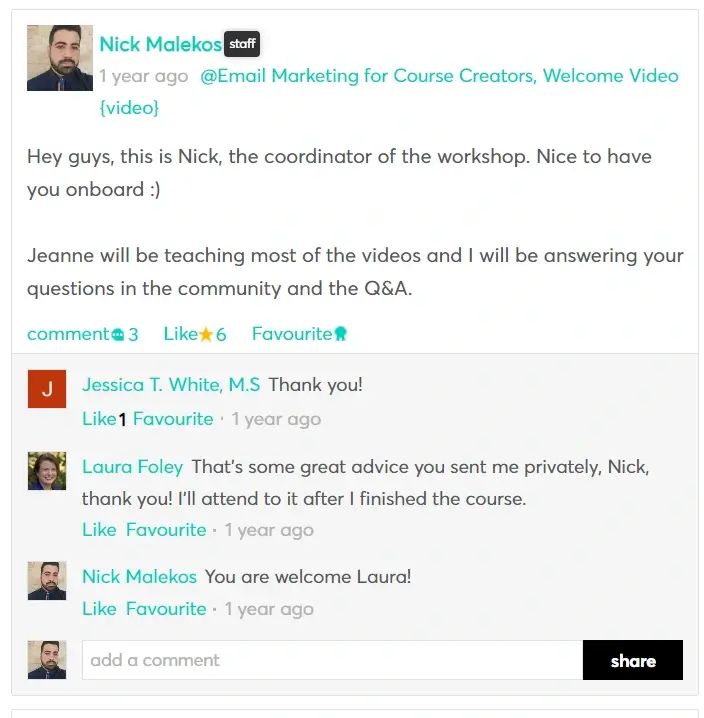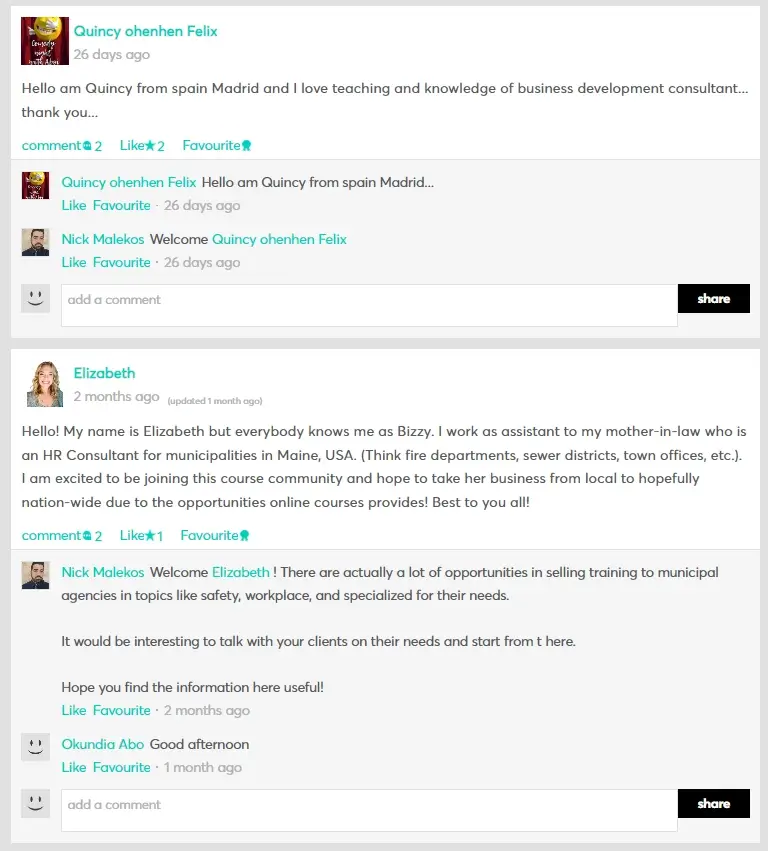Table of Contents
Learning is a social activity in itself. We learn through contact and discourse with another person more competent in the field. Sharing knowledge and ideas is what makes the educational journey and the learning experience even more enriching.
Through productive conversations and collaborative learning, we can continually shape our understanding of any topic at hand and even co-create knowledge.
However, creating a successful online learning community is not as easy as it may seem. It requires a deep understanding of the key components of social learning and the various motivators that drive learner engagement.
In a nutshell, the key components of social learning are:
Building a sustainable online learning community involves balancing these elements and fostering a supportive and engaging environment for learners to thrive. By building an online community around learning, you retain your students’ engagement and improve learning results at the same time!
💁Before you go on, are you looking to create your own learning community? You can do that with LearnWorlds, starting building your online living-learning community within the first 30 days for free.
You can even create a membership-only learning community program for your students if you are an academic institution or for a business’s target audience.
An online learning community is a virtual space that connects people with similar educational interests to share information and resources and support each other’s learning. It is designed to facilitate collaboration, discussion, and knowledge-sharing among its members, who may be students, teachers, professionals, or anyone interested in a particular subject.
The online format allows for the exchange of ideas and resources from anywhere in the world and at any time, making it a flexible and convenient way to learn and grow.
Online learning communities are essential to achieving a productive online learning environment. This is why they are so popular, especially in higher education (e.g., college student groups, faculty members, alumni, etc.).
Types of online learning communities
There sure are a lot of different types of online learning communities. Let’s briefly explore some of the most common ones. Keep in mind that one type of community doesn’t necessarily exclude the others. It’s not an either/or situation; you may find that a blend of different types works best for your learning needs.
8 proven ways to build a sustainable online learning community
Each type of online learning community serves a different purpose and has its own unique features, but all aim to nurture sustainability by offering opportunities for learners to connect, engage, and grow their skills and knowledge over time.
In a sustainable learning community, there is a balance between the needs of the individual learners and the community’s needs as a whole. Members are encouraged to provide a sort of community service by supporting one another while also receiving support and guidance in their own learning journeys. Members find ways to explore, think, innovate, develop skills, and seek conceptual understanding- things they wouldn’t achieve independently.
These learning experiences instill a sense of belonging and camaraderie that keeps online learners engaged and motivates them to persevere.
Achieving sustainability in a learning community requires careful planning and management, active engagement from all members, and a commitment to continuous improvement.
However, most instructors struggle to make learners participate in the discussion board because learners attend the courses in their time-space.
There are ways that you can use to establish participation gradually and, in the end, a real sense of a sustainable learning community.
A thriving collaborative learning community can be created online in a number of ways. In this article, we will explore the top 8 proven ways to do so.
In this example, you can see what our initial message should look like:

Don’t forget that your initial postings in the discussion forum, your first messages sent to all by email, or the greeting you post on your course home page will do much to set the tone and expectations for your course.
Announcements help us build a stronger rapport with our learners.
News and announcements make you seem active. You are the half part of the equation.
Depending on your preferences and those of your learners, you can also send emails, texts, push notifications, or social media messages that repeat online announcements or merely remind learners to log in to view those announcements.
If you send a weekly message via email or some other format (e.g., Twitter), ensure these are identical to any announcements in your online classroom.
Let learners know from the first day of class that each time they log in, they should check for the latest announcements. So, having a uniform announcement area in your course platform is essential.
Here are some examples of announcements:
During the early part of an online course, it is critical for class members to get to know one another and learn to share things from an online class community.
A good idea is to create a discussion thread called “Introduce Yourself.” It’s also fruitful to present yourself too.
These discussion threads enable the instructor to act as a peer mentor and also to identify learners with similar interests and help them to group learners for collaborative work later on in the course. This tactic is even more effective in cohort-based courses where a close-knit community is essential.
Learners must feel free to pose questions either via email (directly to the teacher as a private communication) or by posting on a discussion forum (publicly).
The drawback of the email approach is that the learner is relying on the teacher as the sole provider of information.
It is advisable, therefore, to set up a Q&A discussion thread for the duration of the online course. This not only improves the academic experience but also saves time for the teacher by answering FAQs and encourages communication:
Synchronous communication provides a sense of immediacy, boosts student engagement, and cultivates the feeling of responsiveness among participants.
It also results in quick problem-solving. Real-time chat is probably the most exhausting and intensive activity you will ever encounter in online teaching, yet it is vital to student success.
Your attention must be attuned to rapid-fire comments and questions from several learners.
It is best to plan a live collaboration chat with your learners early on.
That can be achieved with a live class or webinar.
Asynchronous discussion allows time for reflection and encourages more careful consideration of the answers given.
Learners can reflect and think about their responses rather than having to respond immediately.
The shaping of discussions takes some proper forethought.
A discussion integrating specific readings in the textbook, coupled with your guideline questions, will likely be more productive.
One way of promoting meaningful dialogue and questioning is to provide a set of rubrics of the kinds of questions students may want to ask each other:
Tips for a great asynchronous conversation:
In your discussion board, you can create group conversations where smaller groups of learners can interact and also produce crafts. You can use this tactic to build a supportive community of peers in any academic environment (high school, college, etc.) or work environment.
Here are a few strategies for promoting group work and peer-to-peer learning online:
As an extension of your course topics, you might like to create a blog outside the course platform, where learners will post articles, reflections, diary entries, images, links to websites, audio, or video clips, etc.
A community of learners can co-exist and co-develop in several social means concurrently. That will make it even more coherent.
On this special website, you can:
In LearnWorlds Academy, for example, we provide a community page where students, after enrollment, can follow each other, create posts or comments, participate in polls, and also interact with others’ posts by highlighting the best, filtering them, starring them, and much more!

How online learning communities boost engagement and retention
As mentioned, online learning communities play a key role in digital education by keeping learners engaged and improving retention rates. These communities have the power to transform individual study into a connected group experience where collaboration and interaction thrive.
When learners interact with peers, instructors, and experts, they can connect more deeply with the material and stay motivated throughout the learning session. This is a crucial element for the overall success of your learners as well.
Best platforms to host your community of learners
There are many platforms out there that can help you build a vibrant community of learners. Which one you are going to choose needs to be dependent on the features and capabilities you are after. Here are the top 3 options for community platforms you can choose from.
LearnWorlds
Our very own platform, LearnWorlds, is the go-to choice for course creators who want to add a community experience. With discussion boards, live chat, social learning tools, and a built-in Facebook-like community, you can easily create an interactive environment to offer real-time collaboration between you and your learners. LearnWorlds also integrates with your course content so you can blend content delivery with community engagement.
Mighty Networks
Mighty Networks is another great platform for creating communities around online courses. You can host paid and free communities, private groups, course-specific discussions, and interactive events. Perfect for building engaged digital learning networks.
Teachable
Teachable allows course creators to build communities through its built-in discussion and group coaching features. It also integrates with many 3rd party tools, so it’s a great option if you want to add community to your course.
When selecting a platform, look into factors such as ease of use, scalability, and the specific engagement tools that you believe will best serve your community’s needs.
💡Explore more options with this list of the best 17 community platforms.
Benefits of an elearning community for businesses
Elearning communities provide substantial value for businesses seeking to develop their learners’ skills, whether these are their employees, customers, or partners.
When you build these digital learning spaces, your team members feel supported, motivated, and ready to expand their capabilities. But there’s always more.
Increased engagement and collaboration
An elearning community encourages your learners to interact with one another, share ideas, and work together on solving problems.
This interaction creates a more engaged workforce where team members actively participate in learning activities and apply new skills in their daily work.
Improved knowledge retention
When your employees actively engage with peers and mentors, they retain more of what they learn.
Elearning communities provide spaces for ongoing discussions, review and feedback sessions, and collaborative tasks that reinforce key concepts, making learning stick.
Promoting a culture of continuous learning
Building an elearning community helps develop a culture where learning becomes part of everyday work.
Your employees, for example, gain access to resources, knowledge-sharing opportunities, and peer support that encourages them to continue developing their skills. This approach benefits your business through measurable improvements in skill levels and productivity.
Networking and mentorship
Within an elearning community, your employees can connect with mentors, share career insights, and expand their professional networks.
These connections create a more supportive work environment and contribute to improved employee satisfaction.
Long-term benefits
For businesses preparing their teams for evolving workplace demands, integrating an elearning community into your development strategy creates tangible returns through improved employee performance, satisfaction, and retention. All three in one.
💡Check examples of successful virtual learning communities and learn how to build yours.
Final thoughts
Sharing is caring. Sharing is thinking together, negotiating, collaborating, and co-creating.
These are the main elements of productive communities of learning.
The cycles of sharing, commenting, responding, and synthesizing among learners promote community-building emotions since learners no longer focus solely on their understanding.
Why not give the techniques we’ve discussed in this article a shot? We’d love to hear how it goes for you; let us know your experiences and any feedback you have. We’re here to help and support you in your learning journey.
Also, take a look at how you can interact socially with learners inside LearnWorlds and get some ideas on how comments, messages, posts, and course discussions come alive there.
If you want to create your own online learning community, you can get a 30-day free trial of LearnWorlds.
Rosemary is LearnWorlds’ Content Marketing Manager. She has over 2 decades of experience in omnichannel marketing and content writing for the IT and SaaS industry. Her expertise lies in crafting effective content marketing strategies that attract, engage, and nurture customers, enabling LearnWorlds to reach its target audiences with precision.
Kyriaki is the SEO Content Manager at LearnWorlds, where she writes and edits content about marketing and e-learning, helping course creators build, market, and sell successful online courses. With a degree in Career Guidance and a solid background in education management and career development, she combines strategic insight with a passion for lifelong learning. Outside of work, she enjoys expressing her creativity through music.
FAQ
Everything you have ever wondered, but were too afraid to ask...
Some of the top LMS platforms for building a strong learning community are:
When searching for an LMS to build a learning community, you need to look for:



